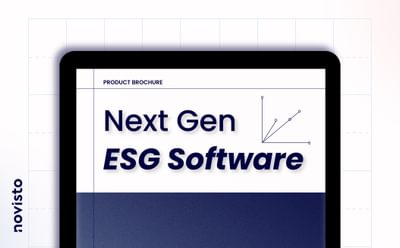
The ESG reporting landscape is complex. With so many frameworks and standards out there, and so much information available for each, it can be hard to know which disclosure mechanism will best serve your company and its stakeholders.
In this post, we explore four of the most popular ESG reporting references to help you determine whether they’re right for your organization’s corporate sustainability reporting initiatives.
SASB (Sustainability Accounting Standards Board)
What it is
The Sustainability Accounting Standards Board (SASB), which merged with the International Integrated Reporting Council (IIRC) in 2021 to create the Value Reporting Foundation (VRF), offers companies a set of industry-specific standards for disclosing potentially financially material sustainability information to their investors.
How it works
SASB released 77 industry-specific standards that serve as the potential and likely set of financially material sustainability topics and metrics for any company, in any industry. On average, each standard consists of six disclosure topics and 13 accounting metrics.
SASB has developed a Materiality Finder that serves as a visual guide to help businesses identify their material issues. SASB also provides several guidance documents to help investors and companies implement the SASB standards.
How it complements others
SASB standards can be used in conjunction with principles-based frameworks, such as the TCFD. While SASB focuses on the financial consequences of a broad range of sustainability topics, TCFD focuses specifically on how climate-related issues affect financial performance. That said, the SASB standards are complementary to the TCFD framework, and offer guidance on satisfying TCFD requirements in your SASB reporting. The SASB standards also complement the GRI standards, and many companies use a combination of SASB, GRI and TCFD to meet the information needs of multiple stakeholders and audiences.
An update on SASB
Effective August 1, 2022, the Value Reporting Foundation was consolidated into the IFRS Foundation, at which point the IFRS Foundation’s International Sustainability Standards Board (ISSB) assumed responsibility for the SASB standards. The ISSB has committed to build on the industry-based SASB standards and leverage SASB’s industry-based approach to standards development. The ISSB has also been encouraging companies and investors to continue to use SASB standards.
GRI (Global Reporting Initiative)
What it is
The Global Reporting Initiative (GRI) is a series of globally applicable, universal sustainability reporting standards. These standards detail the disclosure requirements for a comprehensive range of environmental, social, and governance issues. A significant number of companies around the world rely on GRI standards in their sustainability reports and ESG disclosures. Moreover, some even use GRI reporting software to facilitate the reporting process.
How it works
GRI Standards are modular and interrelated. They are designed to be used as a set, helping to identify and measure a company’s impact materiality. The standards include universal standards (applies to all organizations), sector standards (sector-specific impacts) and topic standards (disclosures relevant to particular topics).
GRI’s materiality principle (see p.15-17 of the GRI 2021 FAQ) establishes a framework to help companies identify their most significant environmental, social, and economic impacts based on the nature of their business.
After identifying the most significant impacts of their activities and business relationships on the economy, environment, and people, companies can select relevant material topics to report on through the appropriate topic standards.
How it complements others
What sets the GRI standards apart is the completeness of their standards. The GRI is a rigorous prescriptive tool that outlines the entirety of an ESG report and the reporting process. Importantly, GRI involves identifying material topics based on impacts and then applying appropriate information for disclosures on all material performance indicators. This is different from the SASB standards, which view materiality in a fundamentally different way and have already identified the key material issues for each industry. Companies will often use both the GRI standards and the SASB standards together.
TCFD (Task Force on Climate-related Financial Disclosures)
What it is
The Task Force on Climate-related Financial Disclosures (TCFD) is an ESG reporting framework that identifies climate-related financial risks and opportunities for companies to manage and report on. It also offers guidance on disclosing these risks and opportunities to a variety of stakeholders.
The TCFD was created specifically for climate-related disclosures by the Financial Stability Board, after the board identified climate change as a systemic risk to the financial system. The driving principle behind the TCFD is that increasing the amount of reliable information on financial institutions’ exposure to climate-related risks and opportunities will strengthen the stability of the financial system, contribute to a greater understanding of climate risks, and facilitate the financing of the transition to a more stable and sustainable economy.
The TCFD is one of the most widely recommended and adopted ESG reporting frameworks. It is quite forward-looking, recommending that companies disclose a long-term planning horizon and scenario analysis. It is a useful tool for determining how a company should act based on its long-term strategy and risk management planning. The TCFD also addresses the concept of double materiality.
How it works
The TCFD’s 11 core recommendations within four pillars (Governance, Strategy, Risk management, Metrics and Targets) help organizations understand the disclosures required by financial markets in order to measure and respond to climate change risks, and encourage firms to align their disclosures with investors’ needs.
How it complements others
The TCFD is well aligned with the CDP. GRI is complementary to TCFD, and many companies use a combination of GRI, SASB, and TCFD.
CDP (previously the Carbon Disclosure Project)
What it is
Previously known as the Carbon Disclosure Project, the CDP is a global environmental disclosure system in the form of a questionnaire. The CDP asks companies to provide information about how they manage climate change, water security, and deforestation. This disclosure system is not just for companies — it’s also used by investors, cities, states, and regions to manage their environmental impacts.
How it works
The CDP provides organizations with a questionnaire for each of the environment-related topics it covers (climate change, water, and forests). The CDP is not a tool for determining financial materiality; rather, each questionnaire includes general questions alongside sector-specific questions aimed at high-impact sectors.
Because CDP can disclose your information to the public (provided your company consents), companies need to be careful that the information they provide in a CDP questionnaire is suitable for public disclosure. Therefore, it’s helpful to have published ESG reports previously, and use this information as the basis for completing your CDP questionnaire.
How it complements others
The CDP questionnaire is a unique ESG tool that companies are asked to complete. CDP’s climate change questionnaire is fully aligned with the TCFD recommendations. In other words, companies that fully answer CDP would satisfy the TCFD recommendations.
Getting started with ESG reporting
Getting started with ESG reporting frameworks and standards can feel overwhelming, but there are experts and tools available to help you make the first step. Before researching which reporting schemes are best for you, we recommend identifying your company’s material issues and objectives. Who is the report for? Who will read it, and why are you publishing an ESG report? What do you want to disclose and talk about? These questions can influence the ESG reporting frameworks and standards you select, so take your time getting clarity on your intentions.
How Novisto can help
With the right partner, navigating ESG reporting frameworks becomes far easier — and far more valuable. Novisto’s next generation sustainability management software lets you create value from your ESG strategy, data, and reporting. With the Novisto platform, you can harness the power of quality data to measure, track, and improve on key ESG metrics, and own your ESG narrative. Talk to Novisto about how we can help today.
